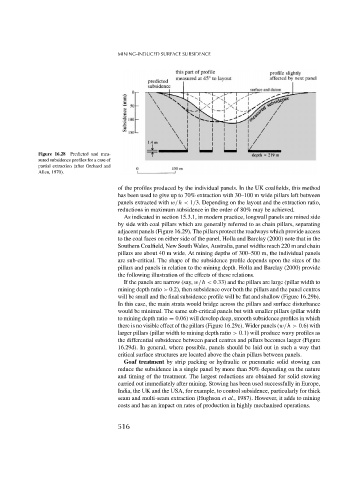Page 534 - Rock Mechanics For Underground Mining
P. 534
MINING-INDUCED SURFACE SUBSIDENCE
Figure 16.28 Predicted and mea-
sured subsidence profiles for a case of
partial extraction (after Orchard and
Allen, 1970).
of the profiles produced by the individual panels. In the UK coalfields, this method
has been used to give up to 70% extraction with 30–100 m wide pillars left between
panels extracted with w/h < 1/3. Depending on the layout and the extraction ratio,
reductions in maximum subsidence in the order of 80% may be achieved.
As indicated in section 15.3.1, in modern practice, longwall panels are mined side
by side with coal pillars which are generally referred to as chain pillars, separating
adjacent panels (Figure 16.29). The pillars protect the roadways which provide access
to the coal faces on either side of the panel. Holla and Barclay (2000) note that in the
Southern Coalfield, New South Wales, Australia, panel widths reach 220 m and chain
pillars are about 40 m wide. At mining depths of 300–500 m, the individual panels
are sub-critical. The shape of the subsidence profile depends upon the sizes of the
pillars and panels in relation to the mining depth. Holla and Barclay (2000) provide
the following illustration of the effects of these relations.
If the panels are narrow (say, w/h < 0.33) and the pillars are large (pillar width to
mining depth ratio > 0.2), then subsidence over both the pillars and the panel centres
will be small and the final subsidence profile will be flat and shallow (Figure 16.29b).
In this case, the main strata would bridge across the pillars and surface disturbance
would be minimal. The same sub-critical panels but with smaller pillars (pillar width
to mining depth ratio = 0.06) will develop deep, smooth subsidence profiles in which
there is no visible effect of the pillars (Figure 16.29c). Wider panels (w/h > 0.6) with
larger pillars (pillar width to mining depth ratio > 0.1) will produce wavy profiles as
the differential subsidence between panel centres and pillars becomes larger (Figure
16.29d). In general, where possible, panels should be laid out in such a way that
critical surface structures are located above the chain pillars between panels.
Goaf treatment by strip packing or hydraulic or pneumatic solid stowing can
reduce the subsidence in a single panel by more than 50% depending on the nature
and timing of the treatment. The largest reductions are obtained for solid stowing
carried out immediately after mining. Stowing has been used successfully in Europe,
India, the UK and the USA, for example, to control subsidence, particularly for thick
seam and multi-seam extraction (Hughson et al., 1987). However, it adds to mining
costs and has an impact on rates of production in highly mechanised operations.
516

